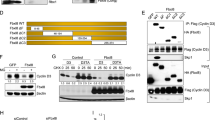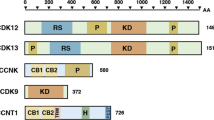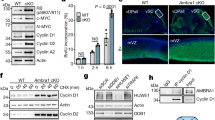Abstract
Cancers often exhibit high levels of cyclin E expression, and aberrant cyclin E activity causes genomic instability and increased tumorigenesis. Two tumor suppressor pathways protect cells against cyclin E deregulation. The p53 pathway is induced by excess cyclin E in primary cells and opposes cyclin E activity through induction of p21Cip1. In contrast, the Fbw7 pathway targets cyclin E for degradation, and Fbw7 mutations occur commonly in cancers. We investigated the cooperativity of these two pathways in countering cyclin E-induced genomic instability in primary human cells. We find that loss of p53 and Fbw7 synergistically unmasks cyclin E-induced instability. In normal cells, impaired cyclin E degradation produces genome instability, but this is rapidly mitigated by induction of p53 and p21. In contrast, p53 loss allows the high level of cyclin E kinase activity that results from Fbw7 loss to persist and continuously drive genome instability. Moreover, p21 plays a critical role in suppressing cyclin E when Fbw7 is disabled, and in the absence of p21, sustained cyclin E activity induces rapid cell death via apoptosis. These data directly demonstrate the cooperative roles of these Fbw7 and p53 pathways in restraining cyclin E activity and its associated genome instability.
This is a preview of subscription content, access via your institution
Access options
Subscribe to this journal
Receive 50 print issues and online access
$259.00 per year
only $5.18 per issue
Buy this article
- Purchase on Springer Link
- Instant access to full article PDF
Prices may be subject to local taxes which are calculated during checkout



Similar content being viewed by others
References
Clurman BE, Sheaff RJ, Thress K, Groudine M, Roberts JM . (1996). Turnover of cyclin E by the ubiquitin–proteasome pathway is regulated by cdk2 binding and cyclin phosphorylation. Genes Dev 10: 1979–1990.
Dumaz N, Meek DW . (1999). Serine15 phosphorylation stimulates p53 transactivation but does not directly influence interaction with HDM2. EMBO J 18: 7002–7010.
Ekholm-Reed S, Mendez J, Tedesco D, Zetterberg A, Stillman B, Reed SI . (2004). Deregulation of cyclin E in human cells interferes with prereplication complex assembly. J Cell Biol 165: 789–800.
Geng Y, Lee YM, Welcker M, Swanger J, Zagozdzon A, Winer JD et al. (2007). Kinase-independent function of cyclin E. Mol Cell 25: 127–139.
Hwang HC, Clurman BE . (2005). Cyclin E in normal and neoplastic cell cycles. Oncogene 24: 2776–2786.
Koepp DM, Schaefer LK, Ye X, Keyomarsi K, Chu C, Harper JW et al. (2001). Phosphorylation-dependent ubiquitination of cyclin E by the SCFFbw7 ubiquitin ligase. Science 294: 173–177.
Loeb K, Kostner H, Firpo E, Norwood T, Tsuchiya K, Clurman BE et al. (2005). A mouse model for cyclin E-dependent genetic instability and tumorigenesis. Cancer Cell 8: 35–47.
Mao JH, Perez-Losada J, Wu D, Delrosario R, Tsunematsu R, Nakayama KI et al. (2004). Fbxw7/Cdc4 is a p53-dependent, haploinsufficient tumour suppressor gene. Nature 432: 775–779.
Minella AC, Swanger J, Bryant E, Welcker M, Hwang H, Clurman BE . (2002). p53 and p21 form an inducible barrier that protects cells against cyclin E-cdk2 deregulation. Curr Biol 12: 1817–1827.
Minella AC, Welcker M, Clurman BE . (2005). Ras activity regulates cyclin E degradation by the Fbw7 pathway. Proc Natl Acad Sci USA 102: 9649–9654.
Moberg KH, Bell DW, Wahrer DC, Haber DA, Hariharan IK . (2001). Archipelago regulates cyclin E levels in Drosophila and is mutated in human cancer cell lines. Nature 413: 311–316.
Nateri AS, Riera-Sans L, Da Costa C, Behrens A . (2004). The ubiquitin ligase SCFFbw7 antagonizes apoptotic JNK signaling. Science 303: 1374–1378.
Noseda M, Chang L, McLean G, Grim JE, Clurman BE, Smith LL et al. (2004). Notch activation induces endothelial cell cycle arrest and participates in contact inhibition: role of p21Cip1 repression. Mol Cell Biol 24: 8813–8822.
Oberg C, Li J, Pauley A, Wolf E, Gurney M, Lendahl U . (2001). The Notch intracellular domain is ubiquitinated and negatively regulated by the mammalian Sel-10 homolog. J Biol Chem 276: 35847–35853.
Orlicky S, Tang X, Willems A, Tyers M, Sicheri F . (2003). Structural basis for phosphodependent substrate selection and orientation by the SCFCdc4 ubiquitin ligase. Cell 112: 243–256.
Polyak K, Waldman T, He TC, Kinzler KW, Vogelstein B . (1996). Genetic determinants of p53-induced apoptosis and growth arrest. Genes Dev 10: 1945–1952.
Rajagopalan H, Jallepalli PV, Rago C, Velculescu VE, Kinzler KW, Vogelstein B et al. (2004). Inactivation of hCDC4 can cause chromosomal instability. Nature 428: 77–81.
Smith AP, Henze M, Lee JA, Osborn KG, Keck JM, Tedesco D et al. (2006). Deregulated cyclin E promotes p53 loss of heterozygosity and tumorigenesis in the mouse mammary gland. Oncogene 25: 7245–7259.
Spruck CH, Strohmaier H, Sangfelt O, Muller HM, Hubalek M, Muller-Holzner E et al. (2002). hCDC4 Gene mutations in endometrial cancer. Cancer Res 62: 4535–4539.
Spruck CH, Won KA, Reed SI . (1999). Deregulated cyclin E induces chromosome instability. Nature 401: 297–300.
Strohmaier H, Spruck CH, Kaiser P, Won KA, Sangfelt O, Reed SI . (2001). Human F-box protein hCdc4 targets cyclin E for proteolysis and is mutated in a breast cancer cell line. Nature 413: 316–322.
Wei W, Jin J, Schlisio S, Harper JW, Kaelin W . (2005). The v-Jun point mutation allows c-Jun to escape GSK3-dependent recognition and destruction by the Fbw7 ubiquitin ligase. Cancer Cell 8: 25–33.
Welcker M, Orian A, Jin J, Grim JA, Harper JW, Eisenman RN et al. (2004). The Fbw7 tumor suppressor regulates glycogen synthase kinase 3 phosphorylation-dependent c-Myc protein degradation. Proc Natl Acad Sci USA 101: 9085–9090.
Welcker M, Singer J, Loeb KR, Grim J, Bloecher A, Gurien-West M et al. (2003). Multisite phosphorylation by Cdk2 and GSK3 controls cyclin E degradation. Mol Cell 12: 381–392.
Won KA, Reed SI . (1996). Activation of cyclin E/CDK2 is coupled to site-specific autophosphorylation and ubiquitin-dependent degradation of cyclin E. EMBO J 15: 4182–4193.
Wu G, Lyapina S, Das I, Li J, Gurney M, Pauley A et al. (2001). SEL-10 is an inhibitor of notch signaling that targets notch for ubiquitin-mediated protein degradation. Mol Cell Biol 21: 7403–7415.
Yada M, Hatakeyama S, Kamura T, Nishiyama M, Tsunematsu R, Imaki H et al. (2004). Phosphorylation-dependent degradation of c-Myc is mediated by the F-box protein Fbw7. EMBO J 23: 2116–2125.
Acknowledgements
We thank Jennifer Williams and Sandeep Mukherjee (Phenopath, Seattle) for assistance with the FISH analyses. This work was supported by National Institutes of Health Grant nos. R01CA84069 and R01CA102742 (to BEC) and Research Career Award K08CA101800 (to ACM).
Author information
Authors and Affiliations
Corresponding author
Rights and permissions
About this article
Cite this article
Minella, A., Grim, J., Welcker, M. et al. p53 and SCFFbw7 cooperatively restrain cyclin E-associated genome instability. Oncogene 26, 6948–6953 (2007). https://doi.org/10.1038/sj.onc.1210518
Received:
Revised:
Accepted:
Published:
Issue Date:
DOI: https://doi.org/10.1038/sj.onc.1210518
Keywords
This article is cited by
-
Loss of FBXW7-mediated degradation of BRAF elicits resistance to BET inhibitors in adult T cell leukemia cells
Molecular Cancer (2020)
-
Insertional mutagenesis using the Sleeping Beauty transposon system identifies drivers of erythroleukemia in mice
Scientific Reports (2019)
-
FBXW7: a critical tumor suppressor of human cancers
Molecular Cancer (2018)
-
Functional significance and therapeutic implication of ring-type E3 ligases in colorectal cancer
Oncogene (2018)
-
Fbw7-dependent cyclin E regulation ensures terminal maturation of bone marrow erythroid cells by restraining oxidative metabolism
Oncogene (2014)



